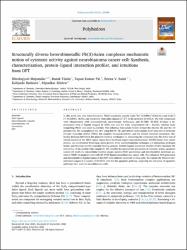| dc.contributor.author | Majumdar, Dhrubajyoti | |
| dc.contributor.author | Tüzün, Burak | |
| dc.contributor.author | Pal, Tapan Kumar | |
| dc.contributor.author | Saini, Reena V | |
| dc.contributor.author | Bankura, Kalipada | |
| dc.contributor.author | Mishra, Dipankar | |
| dc.date.accessioned | 2022-05-13T09:04:40Z | |
| dc.date.available | 2022-05-13T09:04:40Z | |
| dc.date.issued | 24 September 2021 | tr |
| dc.identifier.citation | a Department of Chemistry, Tamralipta Mahavidyalaya, Tamluk 721636, West Bengal, India
b Department of Chemistry, Indian Institute of Technology (Indian School of Mines), Dhanbad, Jharkhand 826004, India
c Sivas Cumhuriyet University, Sivas Vocational School, Department of Plant and Animal Production, TR-58140 Sivas, Turkey
d Department of Chemistry, Pandit Deendayal Petroleum University, Gandhinagar 382007, India
e Department of Biotechnology, Maharishi Markandeshwar (Deemed to be University), Mullana-Ambala, Haryana 133207, India | tr |
| dc.identifier.uri | https://hdl.handle.net/20.500.12418/13008 | |
| dc.description.abstract | In this work, two new heterobimetallic Pb(II) complexes, namely [Zn(L1)(η1-NCS)Pb(η1-SCN)] (1) and [Cd(L2)
(η1-NCS)Pb(η1-SCN)]n (2) integrated from Salen ligands (L1/L2) in the presence of NaSCN. The title compounds
were characterized with microanalytical, spectroscopic techniques, and SC-XRD. SC-XRD divulges a deprotonated
form of ligands trapped by M(II) ions into the N2O2 compartment (M = Zn/Cd), whereas more
compelling Pb(II) ions outer O4 cavities. The tethering thiocyanate linkers formed the discrete (1) and the 1D
polymer (2). We accomplished the DFT using B3LYP, HF, and M062X with Lanl2dz level basis sets to delineate
Frontier molecular orbital (FMO), the complex biological activity, and the Global chemical parameters. Molecular
docking (MD) finds the plausible binding mechanism by implanting the complexes into the active site of
crystal systems of the BRCT repeat region from the breast cancer-associated protein, VEGFR kinase liver cancer
protein, and an allosteric Eya2 lung cancer protein. Polar and hydrophobic exchanges, π-π interaction, hydrogen
bonds, and Bromine are the essential binding process. Protein-Ligand Interaction Profiler (PLIP) examined the
interaction of the protein with complex 1. We consider the mechanistic perception of cytotoxic action, apoptosis
cancer cell death via intracellular reactive oxygen species (ROS) generation, and mitochondrial membrane potential
(MMP) of apoptotic cells with SH-SY5Y human neuroblastoma cancer cells. The enhanced ROS generation
and mitochondrial depolarization in SH-SY5Y cells indicate apoptosis in these cells. We explain the Western blotactivated
caspase-3 in lysates of SH-SY5Y cells for the apoptotic pathway, exploring the induction of apoptotic
pathways via 1 and 2 in neuroblastoma cells. | tr |
| dc.language.iso | eng | tr |
| dc.rights | info:eu-repo/semantics/openAccess | tr |
| dc.subject | Salen ligands | tr |
| dc.subject | Heterobimetallic complex | tr |
| dc.subject | Neuroblastoma cell | tr |
| dc.subject | Cytotoxicity | tr |
| dc.subject | DFT | tr |
| dc.title | Structurally diverse heterobimetallic Pb(II)-Salen complexes mechanistic notion of cytotoxic activity against neuroblastoma cancer cell: Synthesis, characterization, protein–ligand interaction profiler, and intuitions from DFT | tr |
| dc.type | article | tr |
| dc.contributor.department | Sivas Meslek Yüksekokulu | tr |
| dc.identifier.volume | 210 | tr |
| dc.identifier.startpage | 115504 | tr |
| dc.relation.publicationcategory | Uluslararası Editör Denetimli Dergide Makale | tr |















